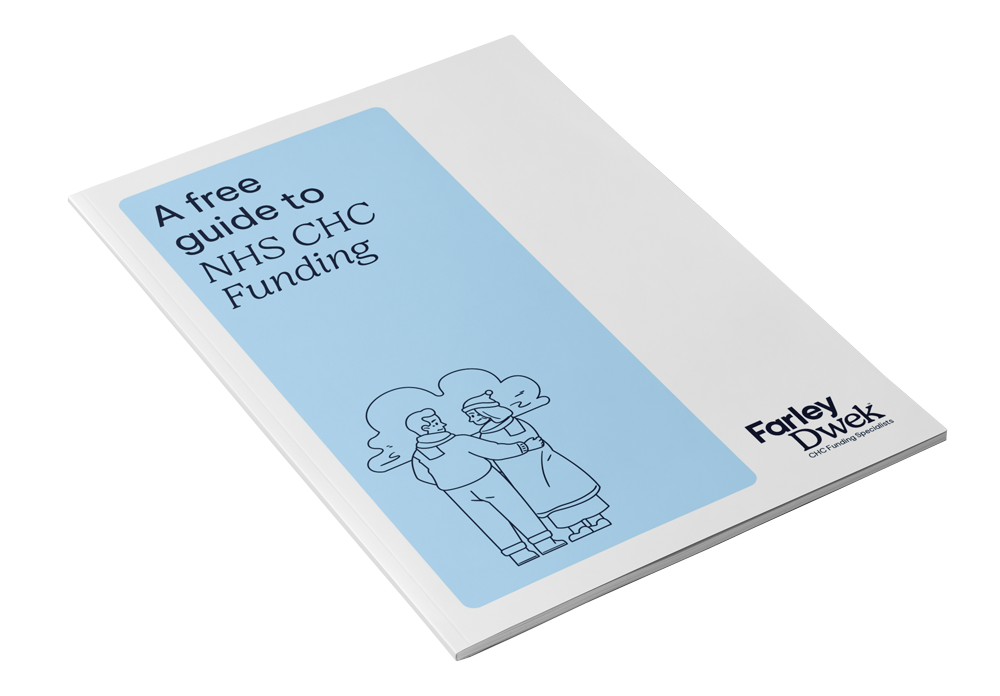What are the 12 care domains of Continuing Healthcare?
The 12 care domains are specific categories used by the NHS to assess a person’s health and social care needs during a Continuing Healthcare (CHC) assessment.
These domains help determine whether someone has a primary health need and are used to decide if the NHS should fund all their care. The domains cover areas such as breathing, nutrition, cognition and behaviour, and provide a structured framework for evaluating how complex, intense or unpredictable a person’s care requirements are.
Each domain is evaluated during the full CHC assessment, using the Decision Support Tool (DST). This process is usually carried out by a Multi-Disciplinary Team (MDT) and determines whether NHS funding will be granted. Needs within each domain are assigned a level of need to reflect the quantity and quality of intervention required, and these findings inform whether the threshold for CHC eligibility is met.
In this article, we’ll explore each of the 12 care domains, with examples, and outline what level of support might be considered significant under NHS Continuing Healthcare criteria.
Jump ahead to each section below:
What are care domains?
The care domains are categories of need set out in the CHC Checklist and Decision Support Tool. These domains help to build a structured and consistent picture of a person’s condition and the complexity, intensity and unpredictability of their care requirements. The NHS uses them to inform the application of the primary health need test at the conclusion of the assessment, which determines whether the individual qualifies for CHC funding.
As part of the assessment, each domain is assessed based on the level of need observed. The descriptors used are:
- No needs
- Low
- Moderate
- High
- Severe*
- Priority*
While a finding of eligibility would be expected in the case of one Priority or two Severe levels of need, the levels of need do not determine the outcome of the assessment. Only the application of the primary health need test – the four Key Characteristics of nature, intensity, complexity and unpredictability – can determine whether the majority of care interventions are for social care (means-tested and the responsibility of the local authority) or healthcare (which should be free at the point of use).
*NB: Not every domain has a Priority or Severe level of need.
What are the 12 care domains?
Breathing
The Breathing domain considers whether the person has any respiratory or other conditions affecting respiration, such as chronic obstructive pulmonary disease (COPD), asthma, pulmonary fibrosis or heart failure. The degree of breathlessness, intervention required and response to management are all important factors in assessing the level of need.
Nutrition (food and drink)
This domain assesses how nutritional needs are met, whether through normal oral intake or alternative means such as PEG feeding, and how much support the individual needs. It also considers the risks associated with choking, aspiration and malnutrition. Individuals who need intensive, skilled support and/or input from specialist clinicians (e.g. Dietitian, Speech & Language, etc.) may score highly in this domain.
Continence
This domain focuses on maintaining good bladder and bowel function, including the management of urinary and faecal incontinence, constipation and urinary tract infections. The need for invasive procedures such as catheterisation, bladder washouts or manual evacuation will increase the degree of need.
Skin
The skin domain explores the condition of the skin, including any existing damage, such as wounds or pressure injuries, and any factors increasing the risk of breakdown. Preventative care measures, such as equipment to relieve pressure, the need for regular repositioning and the application of creams, are all relevant, as is the treatment of any existing wounds. The skillset of the individuals providing the care and the frequency of intervention are important factors to be considered.
Mobility
This domain looks at how the individual moves around and the extent to which they need help to transfer, reposition or mobilise, including any equipment used, such as hoists, slide sheets or specialist seating. The assessors will consider any limitations which increase the difficulty of handling procedures (i.e. pain, spasticity, contractures, hemiplegia, aggression or confusion). The risk of falls or injury – to self or others – and how this is managed, is also important.
Communication
The communication domain reviews the person’s ability to make themselves understood, including the use of communication aids. It includes both verbal and non-verbal communication, factoring in any cognitive or physical impairments that may affect reliable expression and interpretation.
Psychological and emotional needs
This domain looks at factors impacting the individual’s psychological wellbeing, such as depression, anxiety, hallucinations, distress, tearfulness, psychosis or any mental health diagnoses, and examines how these affect them day-to-day. It also considers how these needs are managed and whether specialist input is needed.
Cognition
Cognition relates to the person’s understanding, memory, orientation, decision-making abilities and risk awareness. Cognitive impairment as a result of dementia, stroke or brain injury can affect a person’s ability to understand risk, make appropriate choices or understand their environment. In instances where significant prompts or full supervision are needed to carry out basic tasks, this domain may score highly.
Read more about how cognition is assessed in CHC
Behaviour
This domain focuses on challenging or unpredictable behaviours that may put the person or others at risk, including aggression, disinhibition, resistance to care and self-harm. The severity, frequency and predictability of such behaviours, and the interventions needed to manage them, are all assessed to determine the level of support required.
Drug therapies and medication
This considers the complexity of the individual’s medication regime, how it is administered and whether specialist input is required. It also accounts for the effectiveness of the medications, the severity of any potential side effects, and the consequences of missed doses. The need for polypharmacy and/or the use of controlled drugs might also affect the level of need.
Altered states of consciousness
This domain includes conditions that cause the individual to lose consciousness, such as epilepsy, stroke, transient ischaemia or syncope, and assesses how often these occur, and the level of monitoring or intervention needed to manage the risks.
Other significant care needs
This final domain is designed to capture any ongoing needs that are not covered elsewhere but still require regular intervention or monitoring. It is unusual to see needs in the twelfth domain, but some examples we have seen are autonomic dysreflexia and poikilothermia in the case of those with spinal cord injuries.
Why do the care domains matter?
These 12 care domains are not assessed in isolation, but provide an overview of the way in which needs interact across different areas – critical in determining whether someone is eligible for CHC funding.
Understanding the care domains allows families to prepare for the CHC assessment process, particularly the MDT meeting, and to ensure that nothing important is overlooked. It also provides a clear framework for those considering whether their relative may meet the eligibility criteria.
How Farley Dwek can help
At Farley Dwek, we know that navigating the CHC process can be difficult and overwhelming, especially if your loved one has complex needs that aren’t being fully recognised. We work closely with families to review care records, interpret levels of need and provide expert guidance throughout the assessment process and beyond, offering practical support at every stage.
From reviewing the Decision Support Tool to attending MDT meetings and handling appeals, our expert team includes experienced legal advisers and specialist nurses who understand how each domain is applied in practice and use their insight to help you secure the right outcome.
If you’re unsure whether you or your relative meets the criteria, or you want help preparing for a CHC review or assessment, we’re here to help you understand your rights and get the care funding your family may be entitled to.
See how we can support your family
Need support or advice?
Speak to our team at Farley Dwek and call us for free initial advice on 01612 725 222 or fill in our contact form to leave a message.



